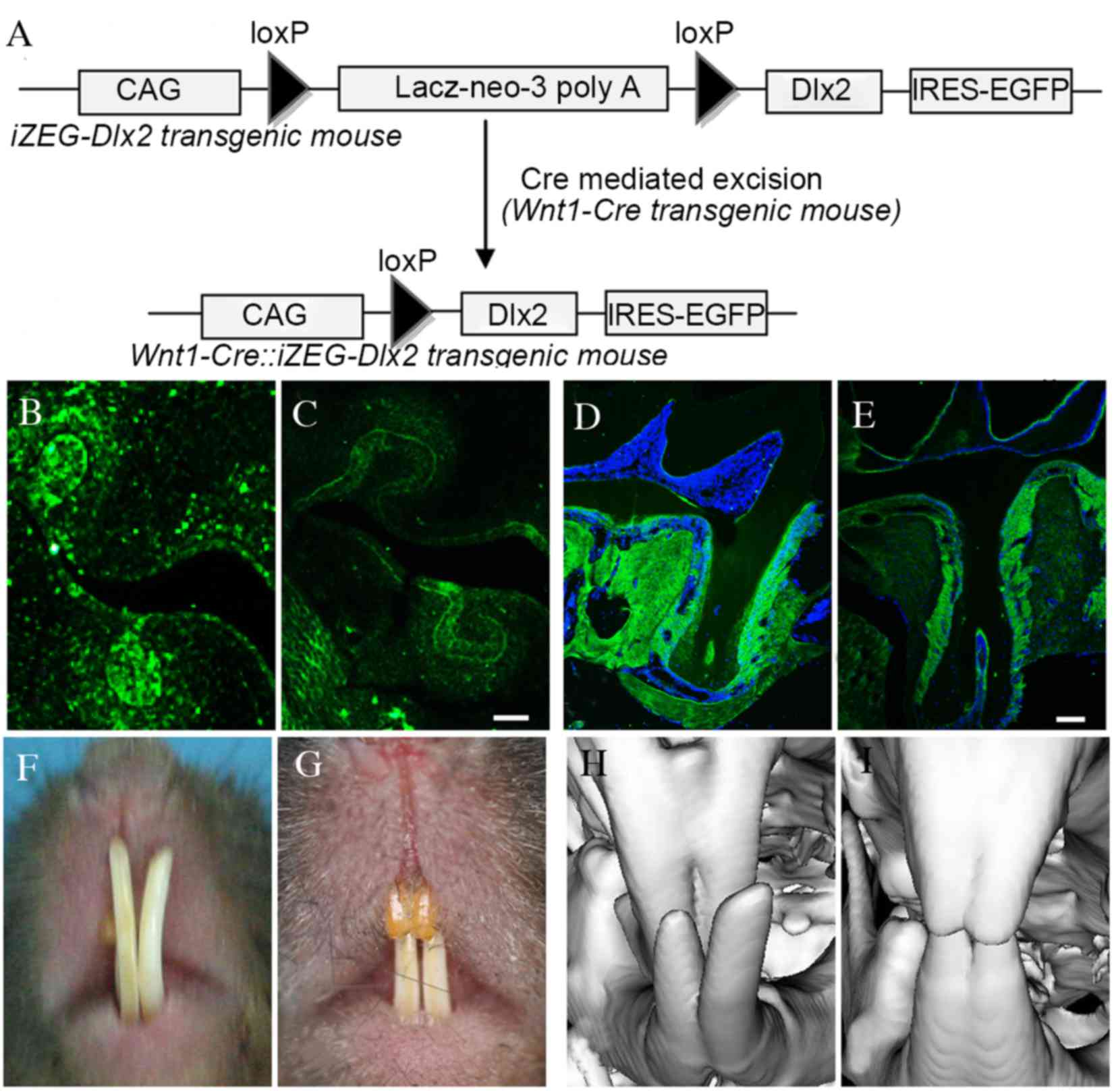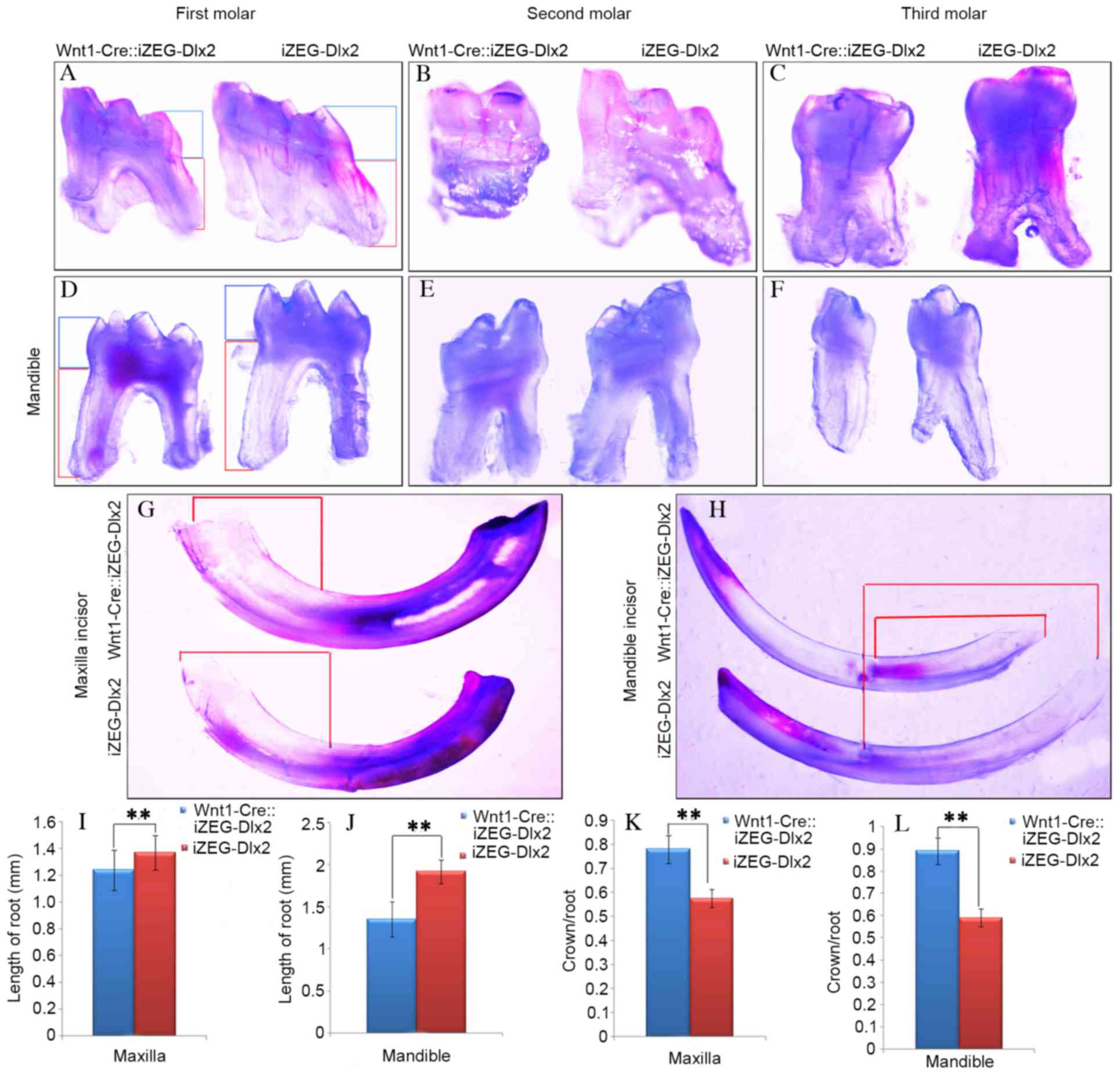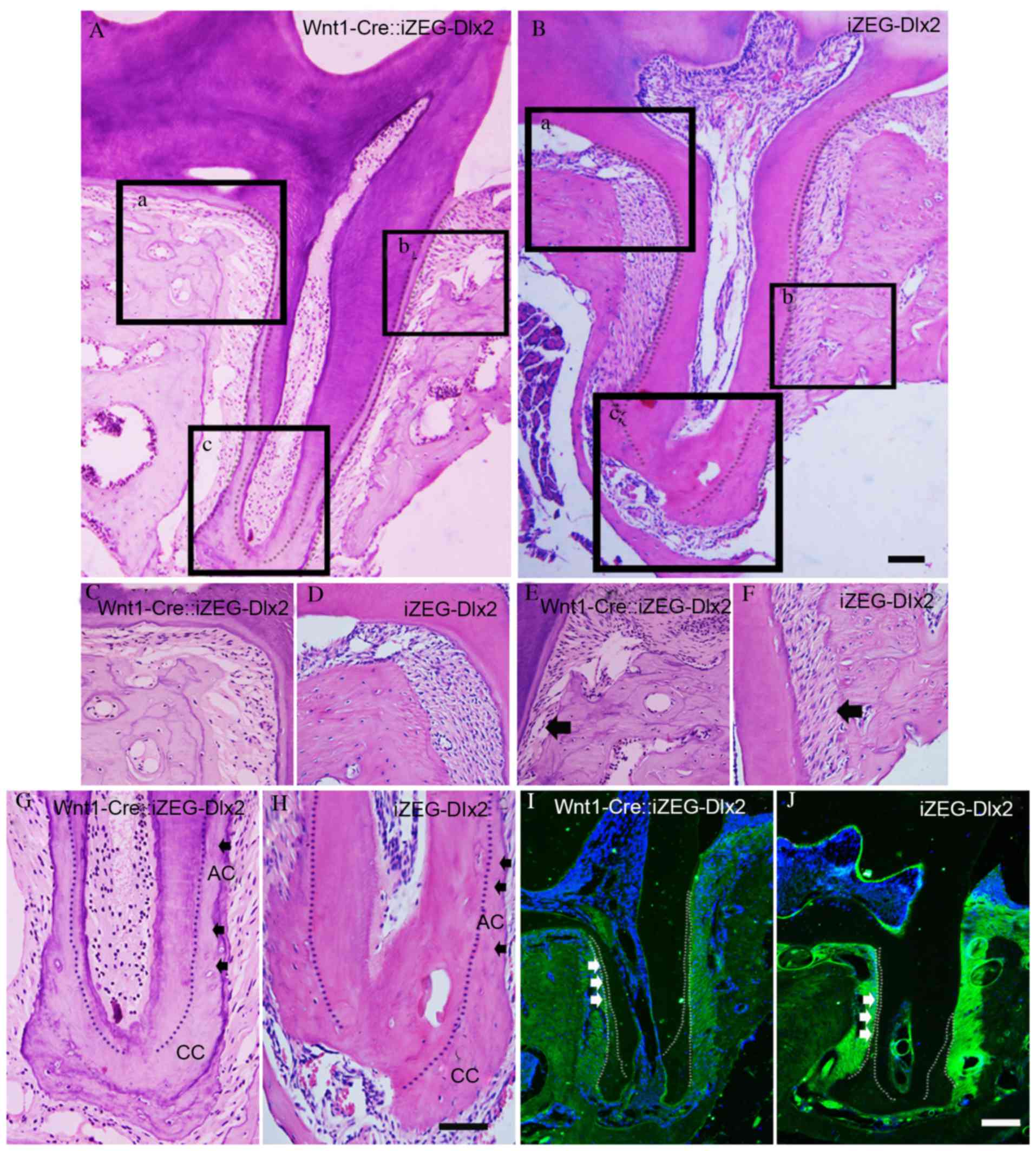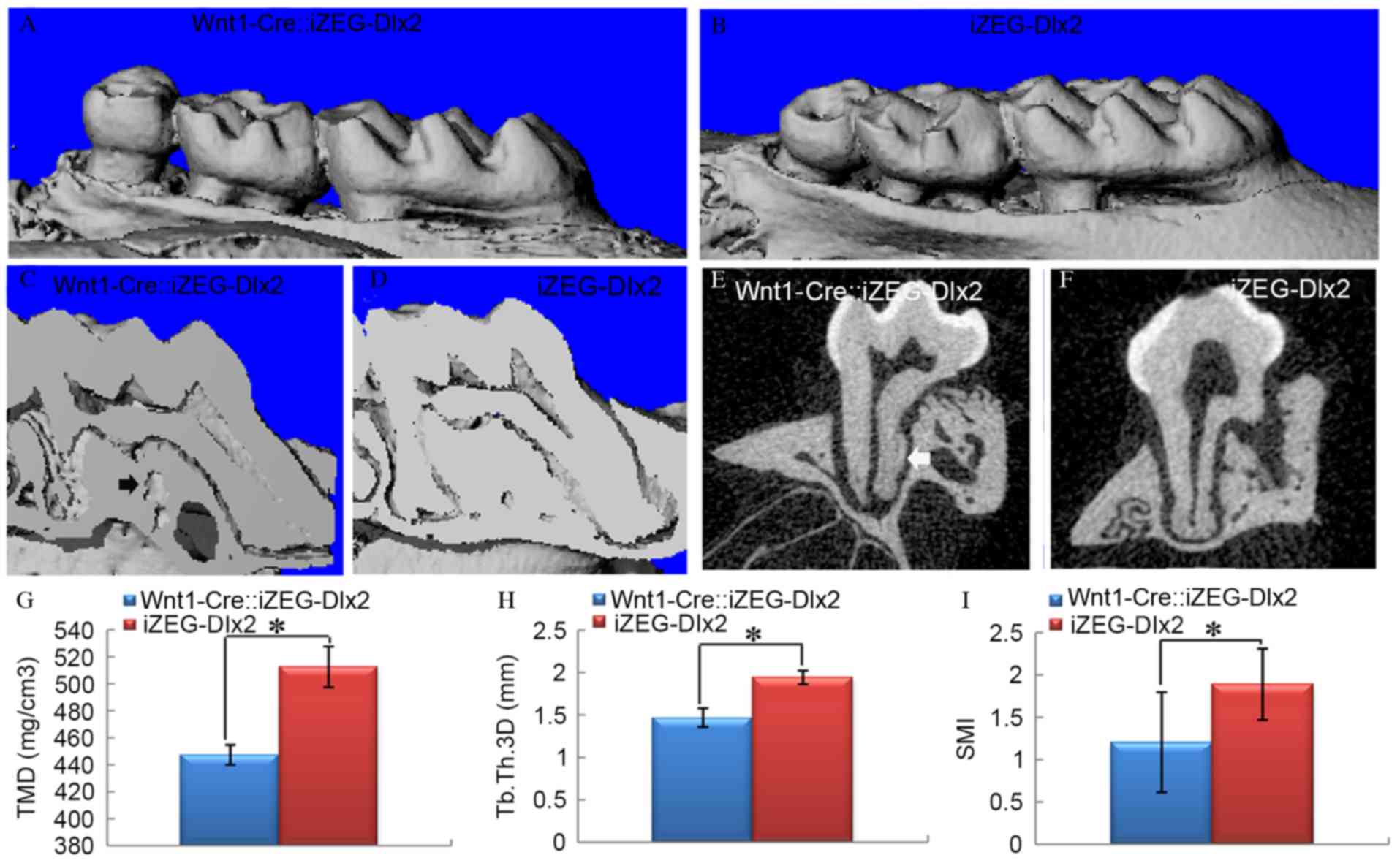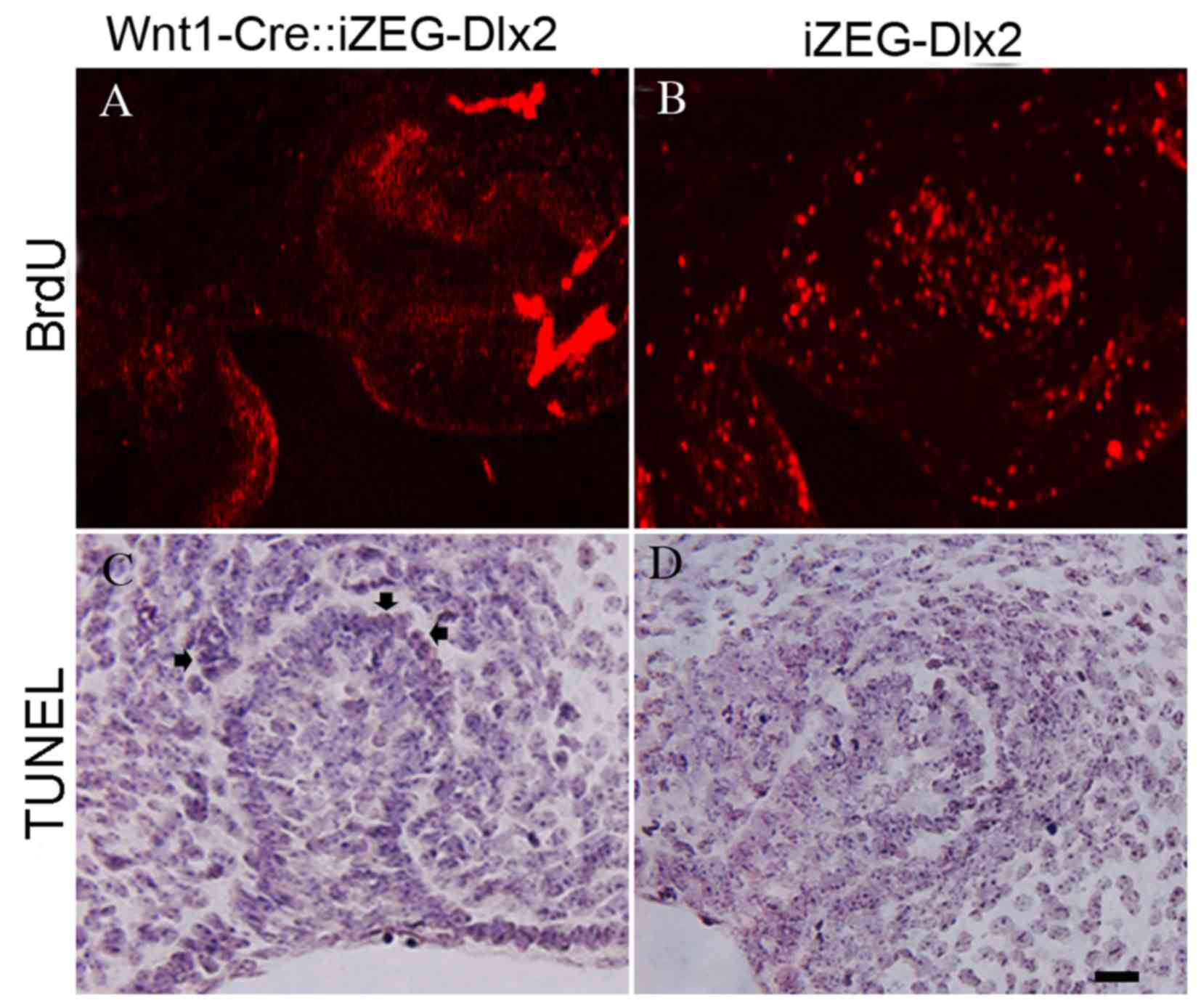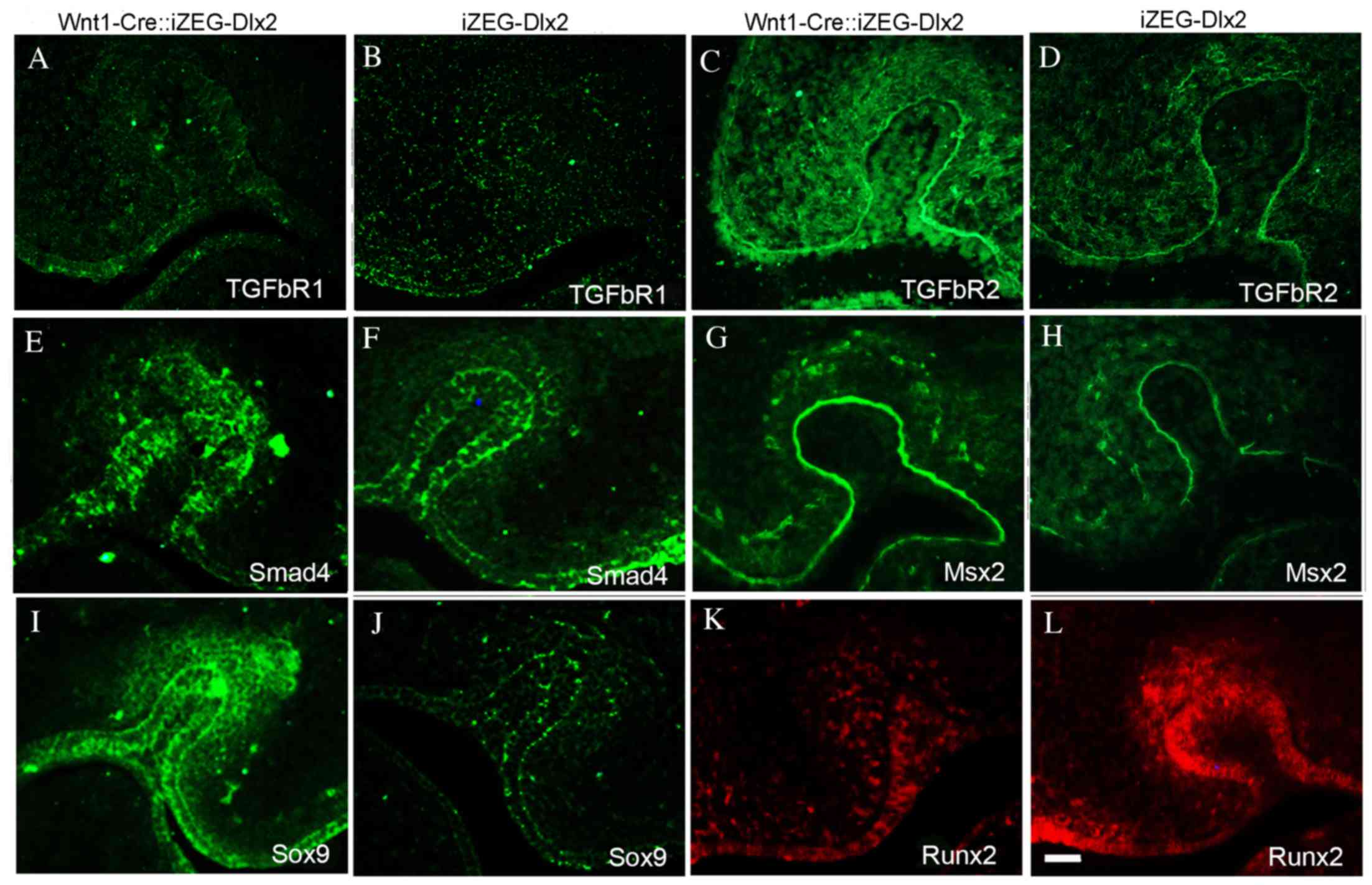Dental and periodontal phenotypes of Dlx2 overexpression in mice
- Authors:
- Published online on: March 10, 2017 https://doi.org/10.3892/mmr.2017.6315
- Pages: 2443-2450
-
Copyright: © Dai et al. This is an open access article distributed under the terms of Creative Commons Attribution License.
Abstract
Introduction
Epithelial-mesenchymal interactions are important for tooth development and various molecules, including bone morphogenetic protein 4 (Bmp4), lymphoid enhancer binding factor 1, Wnt family member 10A, distal-less homeobox 2 (Dlx2), Dlx5 and msh homeobox 1 (Msx1) are expressed during these processes and have been demonstrated to be important components of the tooth initiation and odontogenic patterning signaling pathways (1–6). Dlx2 is a member of the vertebrate Dlx gene family, which is composed of six members organized into three convergent pairs of genes on chromosome 2 in mice (7,8). Dlx1 and Dlx2 are expressed in the epithelium and the cranial neural crest cell (CNCC)-derived mesenchyme of the mandibular and maxillary processes, and these genes are important for the development of craniofacial skeleton tissues (9–11). Previous studies revealed that Dlx2-null and overexpressing mutants exhibited malformation of craniofacial tissues (11–16). Thomas et al (17) reported that the development of maxillary molars required regional specification of a population of CNCCs by the Dlx1 and Dlx2 homeobox genes, and newborn mice with null mutations in the Dlx1 and Dlx2 genes had no maxillary molars; however, all other teeth were present (17). This phenotype may be due to a defect in the mesenchyme whereby odontogenic cells are reprogrammed to become chondrogenic, resulting in the replacement of maxillary molar teeth with ectopic cartilage. An ‘odontogenic homeobox code’ for dentition patterning based on the spatially restricted expression of homeobox genes in the first branchial arch mesenchyme was previously proposed. It was also proposed that the Dlx1 and Dlx2 genes were specifically involved in the pattern of molar tooth development (17). Lézot et al (18,19) also reported that Dlx2 expression was evident in the molar and incisor root epithelia during initial root formation and may constitute a landmark for cementoblast subpopulations of epithelial origin involved in root morphogenesis and cementogenesis (18,19). A previous study revealed that the deletion or mutation of Dlx3 may lead to major dentin defects through changes in the regulation of dentin sialophosphoprotein (20).
However, it is clear from previous Dlx2-knockout studies that Dlx2 may contribute to tooth development and whether Dlx2 overexpression may influence the in vivo phenotypes of dental structures in mammals remains to be elucidated. The present study used a transgenic mouse overexpressing Dlx2 in neural crest cells (NCCs) to determine how Dlx2 overexpression influences dental and periodontal tissues in mice. This analysis revealed that the mice exhibited tooth abnormalities, including incisor cross-bite, shortened tooth roots, increased cementum deposition, periodontal ligament (PDL) disorganization and osteoporotic alveolar bone.
Materials and methods
Mouse strains
Wnt1-Cre transgenic mice were obtained from the Jackson Laboratory for Genomic Medicine (Farmington, CT, USA). Previous studies used Wnt1-Cre mice crossed with Rosa R26R reporter mice to indicate precisely where and when the Cre recombinase was active during tooth development, including condensed dental mesenchyme, dental papilla, dental pulp, odontoblasts, dentine matrix, cementum and PDL, and used these mice to investigate the functions of genes in CNCCs during tooth development (2,21). Transgenic mice conditionally overexpressing Dlx2 (iZEG-Dlx2) were constructed as described in our previous study (13). Wnt1-Cre transgenic mice were mated with iZEG-Dlx2 transgenic mice to obtain double transgenic offspring (Wnt1Cre::iZEG-Dlx2) that specifically overexpressed Dlx2 in tissues derived from NCCs and the mice were genotyped with polymerase chain reaction (PCR) using primers to detect Cre recombinase (Cre) and enhanced green fluorescent protein (EGFP), as described in our previous study (13). Mice (including male and female mice) from a C57BL/6J genetic background were used in the current study and non-recombined littermates were used as controls. All mice were housed in a specific pathogen-free laboratory animal room at a temperature of 22°C. The light cycle consisted of 12 h light and 12 h dark. The animal experimental procedures were performed in compliance with the guidelines of the Institutional Animal Care and Use Committees of the Shanghai Ninth People's Hospital (Shanghai, China) and were approved by the Institutional Animal Care and Use Committees of the Shanghai Ninth People's Hospital (Shanghai, China).
Tooth preparation and measurements
Adult (P90) control (n=6) and Wnt1Cre::iZEG-Dlx2 (n=6) mice (body weight, 25.2–28.3 g) were sacrificed using 0.8% pentobarbital sodium via intraperitoneal injection (100 ml/10 g body weight), skinned and eviscerated, then transferred to 95% ethanol for 2 days. The skulls of mice were then stained with Alcian blue and Alizarin red as previously described (13). The stained teeth were then separated from the alveolar bone under an integrated microscope and were transferred to a solution of 50% glycerol and 50% water for imaging.
The root lengths and the ratios of crown/root length in both the maxillary and mandibular first molars in six control and Wnt1Cre::iZEG-Dlx2 mice (twelve teeth respectively) were quantified using digital hand calipers, and all were performed in triplicate.
Micro-computed tomography (CT) scans
The skulls of P90 iZEG-Dlx2 and Wnt1Cre::iZEG-Dlx2 mice were collected and fixed with 4% paraformaldehyde (PFA). Subsequently, micro-CT data were collected using an eXplore Locus MicroCT scanner (GE Healthcare Life Sciences, Milwaukee, WI, USA), using 0.01-mm-thick slices. The 3D reconstructions of the skulls and bone mineral density calculations were completed using GE MicroView software version 2.2 (GE Healthcare Life Sciences).
Histological analysis
Whole heads of embryonic day 13.5 (E13.5) iZEG-Dlx2 and Wnt1Cre::iZEG-Dlx2 mice (n=6) obtained from pregnant mice following anesthetization with 0.8% pentobarbital sodium via intraperitoneal injection (100 ml/10 g body weight). Jaws of P90 iZEG-Dlx2 and Wnt1Cre::iZEG-Dlx2 mice (n=6) were obtained following anesthetization with 0.8% pentobarbital sodium via intraperitoneal injection (100 ml/10 g body weight) and were dissected and fixed in 4% PFA. P90 jaws were subsequently demineralized in 0.5 M EDTA. The tissues were embedded in paraffin, and 5-µm tissue sections were cut, stained with hematoxylin and eosin (H&E) and mounted with resinous mounting medium.
Analysis of cell proliferation and apoptosis
A total of 10 mg/ml 5-bromo-20-deoxyuridine (BrdU; Sigma-Aldrich; Merck Millipore, Darmstadt, Germany) solution was injected intraperitoneally at a dose of 100 µg/g body weight into pregnant mice (n=3) at E13.5. The mice were sacrificed by anesthetization with 0.8% pentobarbital sodium via intraperitoneal injecion (100 ml/10 g body weight) 2 h after BrdU injection and the embryos were fixed using 4% PFA, embedded in paraffin and cut into 5-µm-thick sections. Subsequently, BrdU-labeled cells were detected using immunofluorescence staining. Terminal deoxynucleotidyl-transferase-mediated dUTP nick end labeling (TUNEL) assays were used to determine apoptosis in the E13.5 mice and the FITC In Situ Cell Death Detection kit (KeyGen Biotech Co., Ltd, Nanjing, China) was used according to the manufacturer's protocol.
Immunohistochemistry
Heads (E10.5) of iZEG-Dlx2 and Wnt1Cre::iZEG-Dlx2 mice (n=6) obtained from pregnant mice, and jaws of P90 iZEG-Dlx2 and Wnt1Cre::iZEG-Dlx2 mice (n=6) were obtained after sacrifice with 0.8% pentobarbital sodium via intraperitoneal injection (100 ml/10 g body weight), following sacrifice with 0.8% pentobarbital sodium via intraperitoneal injection (100 ml/10 g body weight and were embedded in paraffin and sectioned at a thickness of 5 µm. A bone antigen restoration liquid kit (Sunteam Biotech, Shanghai, China) was used for antigen retrieval. Slides were then washed with PBS and blocked for 60 min with 3% bovine serum albumin (Gibco; Thermo Fisher Scientific, Inc., Waltham, MA, USA) in PBS containing 0.2% Triton X-100. The sections were subsequently incubated with primary antibodies for anti-Dlx2 (1:100; cat. no. ab18188; Abcam, Cambridge, UK), anti-osteopontin (1:100; cat. no. ab8448; Abcam), anti-BrdU (1:200; cat. no. ab6326; Abcam), anti-Msx2 (1:150; cat. no. ab69058; Abcam), anti-SMAD family member 4 (Smad4; 1:100; cat. no. BS2050; Bioworld Technology, Inc., St. Louis Park, MN, USA), sex determining region Y-box 9 (Sox9; 1:100; cat. no. BS1597; Bioworld Technology, Inc.), anti-transforming growth factor β receptor 1 (TGFβR1)/TGFβR2 (1:100; cat. nos. BS3257 and BS1696, respectively; Bioworld Technology, Inc.) or anti-runt related transcription factor 2 (Runx2; 1:100; cat. no. MAB2006; R&D Systems, Inc., Minneapolis, MN, USA) overnight at 4°C. The donkey anti-rabbit AlexaFluor 488 and donkey anti-rat AlexaFluor 568 (cat. nos. A21206 and A11077, respectively; Jackson ImmunoResearch Laboratories, Inc., West Grove, PA, USA) secondary antibodies were diluted at 1:300 and incubated with sections for 60 min at room temperature. Finally, slides were mounted with Vectashield mounting medium containing DAPI (Invitrogen; Thermo Fisher Scientific, Inc.) and images were captured using a fluorescence microscope.
Statistical analysis
Data are presented as the mean ± standard deviation. The differences between experimental and control groups were compared with an independent Student's t-test using SPSS version 18.0 (SPSS, Inc., Chicago, IL, USA). P<0.05 was considered to indicate a statistically significant difference.
Results
Overexpression of Dlx2 in the teeth of Wnt1-Cre::iZEG-Dlx2 double transgenic mice
A schematic diagram of the Wnt1-Cre::iZEG-Dlx2 transgene is presented in Fig. 1A, and the mice were genotyped via PCR using primers specific for EGFP and Cre. Cre-mediated NCC-specific recombination was also detected by PCR analysis using a pair of primers spanning the CAG promoter and the Dlx2 coding sequence (CAG-Dlx2 primers), as previously described (13). Immunofluorescence confirmed that Dlx2 expression was higher in the NCCs derivative tissues, including periodontal tissue, cementum and alveolar bone in embryonic and adult Wnt1Cre::iZEG-Dlx2 mice (Fig. 1B-E) when compared with iZEG-Dlx2 control mice, whereas Dlx2 expression exhibited similar level in others tissues, including long bone and liver, between the Wnt1Cre::iZEG-Dlx2 mice and iZEG-Dlx2 control mice.
Overexpression of Dlx2 leads to tooth dysmorphia
P90 Wnt1Cre::iZEG-Dlx2 mice exhibited cross-bite malocclusion (Fig. 1F-I). General observation under an integrated microscope demonstrated that the mandibular and maxillary teeth exhibited shortened root lengths and root morphology dysmorphia (Fig. 2A-H). Measurements of teeth from Wnt1Cre::iZEG-Dlx2 mice and iZEG-Dlx2 mice revealed that root length was significantly reduced (P<0.01; Fig. 2I and J) and the ratios of crown/root length were significantly increased (P<0.01; Fig. 2K and L) in both the maxillary and mandibular first molars in Wnt1Cre::iZEG-Dlx2 mice compared with iZEG-Dlx2 mice.
Overexpression of Dlx2 leads to increased cementum deposition and osteoporotic alveolar bone
The present study performed detailed analyses of the maxillary first molar of Wnt1Cre::iZEG-Dlx2 mice at P90. H&E staining of sagittal sections revealed bone loss and bone defects in the interdental septum and root furcation region in alveolar bone compared with control iZEG-Dlx2 mice (Fig. 3A-H). Notably, increased acellular cementum deposition in Wnt1Cre::iZEG-Dlx2 mice was observed and the molars had sparse and disorganized PDL compared with iZEG-Dlx2 mice. Although the alveolar bone-PDL attachments were defective in Wnt1Cre::iZEG-Dlx2 molars, the cementum-PDL attachments had a normal appearance (Fig. 3E and F). Immunofluorescence results confirmed that the deposition of osteopontin, an osteogenic marker, on the alveolar bone and periodontal tissues was reduced in Wnt1Cre::iZEG-Dlx2 mice compared with iZEG-Dlx2 mice (Fig. 3I and J). The 3D reconstructed images from micro-CT analysis at P90 also confirmed these results (Fig. 4A-F). At P90, tissue mineral density (TMD), trabecular thickness 3D (Tb.Th 3D) and structure model index (SMI) were quantified using micro-CT examination, which indicated a significant reduction in TMD and Tb.Th 3D (P<0.05; Fig. 4G and H), and a significant increase in SMI (P<0.05; Fig. 4I) in the surrounding alveolar bone of Wnt1Cre::iZEG-Dlx2 mice compared with iZEG-Dlx2 mice (Fig. 4), which clearly demonstrated the osteoporosis of the alveolar bone tissue.
Reduced cellular proliferation and increased apoptosis within the dental germ and alveolar bone of E13.5 Wnt1Cre::iZEG-Dlx2 embryos
A marked decrease in cellular proliferation was detected using BrdU-labeling of the dental germ and alveolar bone in E13.5 Wnt1Cre::iZEG-Dlx2 embryos (Fig. 5A and B). TUNEL assays revealed increased apoptosis in the dental germ and alveolar bone in E13.5 Wnt1Cre::iZEG-Dlx2 embryos compared with iZEG-Dlx2 embryos (Fig. 5C and D).
Expression of genes associated with tooth development in Wnt1Cre::iZEG-Dlx2 mice
To identify whether the expression of certain genes that are involved in tooth development was altered by Dlx2 overexpression, the present study used immunofluorescence staining to detect the expression levels of TGFβR1, TGFβR2, Smad4, Msx2, Sox9 and Runx2. The expression levels of TGFβR1, TGFβR2, Smad4 and Msx2, which have previously been demonstrated to contribute to tooth development, were upregulated in the dental germ of E13.5 Wnt1Cre::iZEG-Dlx2 embryos (Fig. 6A-H). Msx2 was also upregulated in the epithelium (Fig. 6G and H). A previous study revealed that a null mutation of Dlx2 may lead to the reprogramming of odontogenic cells to become chondrogenic and express Sox9 (17). The present study revealed that Dlx2-overexpression may also increase Sox9 expression in the dental germ of E13.5 Wnt1Cre::iZEG-Dlx2 mice (Fig. 6I and J). By contrast, the expression of Runx2, an osteogenic and odontogenic marker, was downregulated in the dental germ and alveolar bone of E13.5 Wnt1Cre::iZEG-Dlx2 mice compared with iZEG-Dlx2 (Fig. 6K and L).
Discussion
To the best of our knowledge the present study is the first to describe the effects of Dlx2 overexpression on the formation of dental and periodontal tissues. The current findings suggest that the Dlx2 may be involved in the control of cementum formation. Previous studies revealed that during root cementum formation, cementoblasts exhibited similar characteristics of bone formation to osteoblasts and contribute to matrix deposition in cooperation with periodontal ligament cells (22,23). Molar roots contain two types of cementum: The acellular cementum that is initially deposited, and the cellular cementum that progressively increases in thickness towards the root apex. By contrast, continuously erupted incisors only have acellular cementum (22). A previous study demonstrated that Dlx2 may be continuously present in the epithelial root sheath, from tooth initiation and morphogenesis to the last stages of dental tissue formation and implied that Dlx2 may be involved in the control of cementogenesis (19). The present study determined that Dlx2 overexpression may result in an increased deposition of acellular cementum, indicating that Dlx2 is crucial for the regulation of cementum formation.
Dlx1 and Dlx2 were the first genes to be identified to contribute to odontogenic patterning and their null mutations solely disrupt the development of the maxillary molar, indicating that there are distinct genetic pathways directing the development of different teeth (17,24). However, the present study revealed that the overexpression of Dlx2 disrupted cementogenesis in maxillary and mandibular molars and incisors. It is possible that the expression of other Dlx genes, such as Dlx5 and Dlx1 may compensate for the absence of Dlx2; however, however that cannot inhibit the effects of Dlx2 overexpression. Unlike cementum deposition, Dlx2 overexpression may lead to osteoporotic alveolar bone and downregulation of Runx2 expression, which is consistent with our previous study, which determined that Dlx2 overexpression may impair craniofacial bone development (13). One potential explanation for this discrepancy is that alveolar bone and cementum develop via different molecular mechanisms.
Previous studies have revealed that the development of maxillary molars requires the regional specification of a population of CNCCs by Dlx1 and Dlx2, indicating that the ectoderm mesenchyme may influence tooth morphogenesis (17,24). In the current study, the overexpression of Dlx2 in the neural crest led to disrupted tooth development, confirming this model. Notably, the present study identified that the overexpression of Dlx2 resulted in an ectopic patch of Sox9-expressing cells in the dental germ, whereas a previous study revealed that a null mutation of Dlx2 may also reprogram odontogenic cells to express Sox9 (17). The upregulation and downregulation of Dlx2 expression have similar effects on the expression of Sox9, and the mechanism that leads to these expression patterns remains to be elucidated.
Mice overexpressing Dlx2 exhibited short molar tooth roots, and certain maxillary and mandibular incisors had long crowns and an over-cross bite or curved shape. Potentially, the continuously erupting mouse incisors may have acellular cementum on the lingual root analog, revealing a weaker effect of Dlx2 overexpression when compared with cellular cementum. Additionally, due to the deviation of the maxilla, no natural tooth wear was observed through the consumption of hard foodstuffs and gnawing behavior.
Numerous genes have been reported to be involved in tooth development, including Bmp4, Msx2 and Dlx5, which have also been demonstrated to interact with Dlx2 (1,25). The immunofluorescence results in the present study revealed that Dlx2 overexpression may alter the expression of TGFβR1, TGFβR2, Smad4 and Msx2, the four genes that are crucial for tooth development (1,26,27), in tooth tissue, indicating that Dlx2 may disrupt tooth development by interaction with these genes. However, there are various candidate genes that may interact with Dlx2 to regulate tooth development, the exact molecular associations among these genes remain to be elucidated, and require investigation in the future using bioinformatics analysis and experimental verification of their functions.
In conclusion the present study demonstrated that Dlx2 overexpression in mouse CNCCs resulted in incisor cross-bite, shortened tooth roots, increased deposition of cementum, periodontal ligament disorganization and osteoporotic alveolar bone. Additionally, Dlx2 overexpression increased the expression levels of odontogenesis-associated genes, including TGFβR1, TGFβR2, Smad4, Msx2 and Sox9 in tooth regions. Therefore, the present study suggested that Dlx2 overexpression may alter the alveolar bone, cementum and periodontal ligament phenotypes in mice. It is of note that that the present study was limited in that the dental and periodontal phenotypes were assessed in adult mice, whereas the genetic modification usually occurs during embryogenesis; thus, the primary effects of Dlx2 overexpression may occur early in development. Therefore, it is unclear whether the phenotypes observed were due to developmental defects or postnatal degradation secondary to craniofacial deformity and malnutrition. The exact molecular mechanisms underlying the effects of Dlx2 overexpression on dental and periodontal tissue phenotypes require further investigated in the future.
Acknowledgements
The authors thank Professor Rulang Jiang (Division of Developmental Biology and Plastic Surgery, Cincinnati Children's Hospital Medical Center, Cincinnati, OH, USA) for his advice in experimental design and biological techniques, and Professor John L.R. Rubenstein (University of California San Francisco, San Francisco, CA, USA) for providing the pCAGGS-Dlx2 plasmid. The current study was supported by National Nature Science Foundation of China (grant nos. 81300842 and 81271122), Open Foundation of Beijing Key Laboratory of Tooth Regeneration and Function Reconstruction and Program for Innovation Research Team of Shanghai Municipal Education Commission.
References
|
Saadi I, Das P, Zhao M, Raj L, Ruspita I, Xia Y, Papaioannou VE and Bei M: Msx1 and Tbx2 antagonistically regulate Bmp4 expression during the bud-to-cap stage transition in tooth development. Development. 140:2697–2702. 2013. View Article : Google Scholar : PubMed/NCBI | |
|
Jia S, Zhou J, Gao Y, Baek JA, Martin JF, Lan Y and Jiang R: Roles of Bmp4 during tooth morphogenesis and sequential tooth formation. Development. 140:423–432. 2013. View Article : Google Scholar : PubMed/NCBI | |
|
Zhang Z, Lan Y, Chai Y and Jiang R: Antagonistic actions of Msx1 and Osr2 pattern mammalian teeth into a single row. Science. 323:1232–1234. 2009. View Article : Google Scholar : PubMed/NCBI | |
|
Zhao Z, Stock D, Buchanan A and Weiss K: Expression of Dlx genes during the development of the murine dentition. Dev Genes Evol. 210:270–275. 2000. View Article : Google Scholar : PubMed/NCBI | |
|
Fujimori S, Novak H, Weissenböck M, Jussila M, Gonçalves A, Zeller R, Galloway J, Thesleff I and Hartmann C: Wnt/β-catenin signaling in the dental mesenchyme regulates incisor development by regulating Bmp4. Dev Biol. 348:97–106. 2010. View Article : Google Scholar : PubMed/NCBI | |
|
Sasaki H, Muramatsu T, Kwon HJ, Yamamoto H, Hashimoto S, Jung HS and Shimono M: Down-regulated genes in mouse dental papillae and pulp. J Dent Res. 89:679–683. 2010. View Article : Google Scholar : PubMed/NCBI | |
|
Ozcelik T, Porteus MH, Rubenstein JL and Francke U: DLX2 (TES1), a homeobox gene of the Distal-less family, assigned to conserved regions on human and mouse chromosomes 2. Genomics. 13:1157–1161. 1992. View Article : Google Scholar : PubMed/NCBI | |
|
Stock DW, Ellies DL, Zhao Z, Ekker M, Ruddle FH and Weiss KM: The evolution of the vertebrate Dlx gene family. Proc Natl Acad Sci USA. 93:10858–10863. 1996. View Article : Google Scholar : PubMed/NCBI | |
|
Qiu M, Bulfone A, Ghattas I, Meneses JJ, Christensen L, Sharpe PT, Presley R, Pedersen RA and Rubenstein JL: Role of the Dlx homeobox genes in proximodistal patterning of the branchial arches: Mutations of Dlx-1, Dlx-2, and Dlx-1 and −2 alter morphogenesis of proximal skeletal and soft tissue structures derived from the first and second arches. Dev Biol. 185:165–184. 1997. View Article : Google Scholar : PubMed/NCBI | |
|
Eisenstat DD, Liu JK, Mione M, Zhong W, Yu G, Anderson SA, Ghattas I, Puelles L and Rubenstein JL: DLX-1, DLX-2, and DLX-5 expression define distinct stages of basal forebrain differentiation. J Comp Neurol. 414:217–237. 1999. View Article : Google Scholar : PubMed/NCBI | |
|
Depew MJ, Simpson CA, Morasso M and Rubenstein JL: Reassessing the Dlx code: The genetic regulation of branchial arch skeletal pattern and development. J Anat. 207:501–561. 2005. View Article : Google Scholar : PubMed/NCBI | |
|
Qiu M, Bulfone A, Martinez S, Meneses JJ, Shimamura K, Pedersen RA and Rubenstein JL: Null mutation of Dlx-2 results in abnormal morphogenesis of proximal first and second branchial arch derivatives and abnormal differentiation in the forebrain. Genes Dev. 9:2523–2538. 1995. View Article : Google Scholar : PubMed/NCBI | |
|
Dai J, Kuang Y, Fang B, Gong H, Lu S, Mou Z, Sun H, Dong Y, Lu J, Zhang W, et al: The effect of overexpression of Dlx2 on the migration, proliferation and osteogenic differentiation of cranial neural crest stem cells. Biomaterials. 34:1898–1910. 2013. View Article : Google Scholar : PubMed/NCBI | |
|
McKeown SJ, Newgreen DF and Farlie PG: Dlx2 over-expression regulates cell adhesion and mesenchymal condensation in ectomesenchyme. Dev Biol. 281:22–37. 2005. View Article : Google Scholar : PubMed/NCBI | |
|
Gordon CT, Brinas IM, Rodda FA, Bendall AJ and Farlie PG: Role of Dlx genes in craniofacial morphogenesis: Dlx2 influences skeletal patterning by inducing ectomesenchymal aggregation in ovo. Evol Dev. 12:459–473. 2010. View Article : Google Scholar : PubMed/NCBI | |
|
Jeong J, Cesario J, Zhao Y, Burns L, Westphal H and Rubenstein JL: Cleft palate defect of Dlx1/2-/− mutant mice is caused by lack of vertical outgrowth in the posterior palate. Dev Dyn. 241:1757–1769. 2012. View Article : Google Scholar : PubMed/NCBI | |
|
Thomas BL, Tucker AS, Qui M, Ferguson CA, Hardcastle Z, Rubenstein JL and Sharpe PT: Role of Dlx-1 and Dlx-2 genes in patterning of the murine dentition. Development. 124:4811–4818. 1997.PubMed/NCBI | |
|
Lezot F, Thomas B, Greene SR, Hotton D, Yuan ZA, Castaneda B, Bolaños A, Depew M, Sharpe P, Gibson CW and Berdal A: Physiological implications of DLX homeoproteins in enamel formation. J Cell Physiol. 216:688–697. 2008. View Article : Google Scholar : PubMed/NCBI | |
|
Lezot F, Davideau JL, Thomas B, Sharpe P, Forest N and Berdal A: Epithelial Dlx-2 homeogene expression and cementogenesis. J Histochem Cytochem. 48:277–284. 2000. View Article : Google Scholar : PubMed/NCBI | |
|
Duverger O, Zah A, Isaac J, Sun HW, Bartels AK, Lian JB, Berdal A, Hwang J and Morasso MI: Neural crest deletion of Dlx3 leads to major dentin defects through down-regulation of Dspp. J Biol Chem. 287:12230–12240. 2012. View Article : Google Scholar : PubMed/NCBI | |
|
Chai Y, Jiang X, Ito Y, Bringas P Jr, Han J, Rowitch DH, Soriano P, McMahon AP and Sucov HM: Fate of the mammalian cranial neural crest during tooth and mandibular morphogenesis. Development. 127:1671–1679. 2000.PubMed/NCBI | |
|
Foster BL, Soenjaya Y, Nociti FH Jr, Holm E, Zerfas PM, Wimer HF, Holdsworth DW, Aubin JE, Hunter GK, Goldberg HA and Somerman MJ: Deficiency in acellular cementum and periodontal attachment in bsp null mice. J Dent Res. 92:166–172. 2013. View Article : Google Scholar : PubMed/NCBI | |
|
Fong H, Chu EY, Tompkins KA, Foster BL, Sitara D, Lanske B and Somerman MJ: Aberrant cementum phenotype associated with the hypophosphatemic hyp mouse. J Periodontol. 80:1348–1354. 2009. View Article : Google Scholar : PubMed/NCBI | |
|
Thomas BL and Sharpe PT: Patterning of the murine dentition by homeobox genes. Eur J Oral Sci. 106:(Suppl 1). S48–S54. 1998. View Article : Google Scholar | |
|
Thomas BL, Liu JK, Rubenstein JL and Sharpe PT: Independent regulation of Dlx2 expression in the epithelium and mesenchyme of the first branchial arch. Development. 127:217–224. 2000.PubMed/NCBI | |
|
Zhao H, Oka K, Bringas P, Kaartinen V and Chai Y: TGF-beta type I receptor Alk5 regulates tooth initiation and mandible patterning in a type II receptor-independent manner. Dev Biol. 320:19–29. 2008. View Article : Google Scholar : PubMed/NCBI | |
|
Huang XF and Chai Y: Molecular regulatory mechanism of tooth root development. Int J Oral Sci. 4:177–181. 2012. View Article : Google Scholar : PubMed/NCBI |



